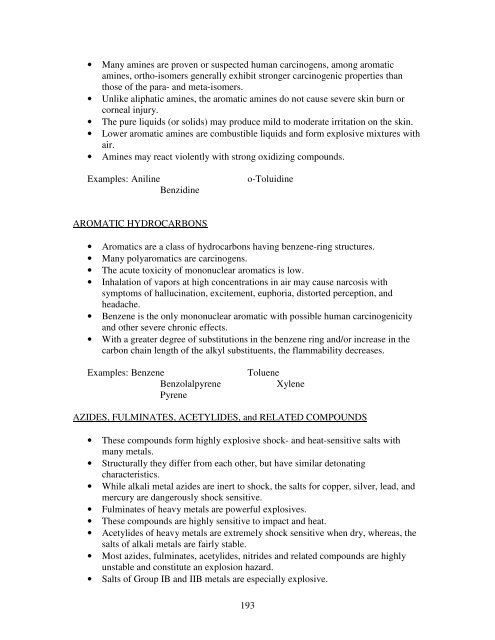Chemical Hygiene Plan - Queensborough Community College ...
Chemical Hygiene Plan - Queensborough Community College ...
Chemical Hygiene Plan - Queensborough Community College ...
Create successful ePaper yourself
Turn your PDF publications into a flip-book with our unique Google optimized e-Paper software.
• Many amines are proven or suspected human carcinogens, among aromatic<br />
amines, ortho-isomers generally exhibit stronger carcinogenic properties than<br />
those of the para- and meta-isomers.<br />
• Unlike aliphatic amines, the aromatic amines do not cause severe skin burn or<br />
corneal injury.<br />
• The pure liquids (or solids) may produce mild to moderate irritation on the skin.<br />
• Lower aromatic amines are combustible liquids and form explosive mixtures with<br />
air.<br />
• Amines may react violently with strong oxidizing compounds.<br />
Examples: Aniline<br />
Benzidine<br />
o-Toluidine<br />
AROMATIC HYDROCARBONS<br />
• Aromatics are a class of hydrocarbons having benzene-ring structures.<br />
• Many polyaromatics are carcinogens.<br />
• The acute toxicity of mononuclear aromatics is low.<br />
• Inhalation of vapors at high concentrations in air may cause narcosis with<br />
symptoms of hallucination, excitement, euphoria, distorted perception, and<br />
headache.<br />
• Benzene is the only mononuclear aromatic with possible human carcinogenicity<br />
and other severe chronic effects.<br />
• With a greater degree of substitutions in the benzene ring and/or increase in the<br />
carbon chain length of the alkyl substituents, the flammability decreases.<br />
Examples: Benzene<br />
Benzolalpyrene<br />
Pyrene<br />
Toluene<br />
Xylene<br />
AZIDES, FULMINATES, ACETYLIDES, and RELATED COMPOUNDS<br />
• These compounds form highly explosive shock- and heat-sensitive salts with<br />
many metals.<br />
• Structurally they differ from each other, but have similar detonating<br />
characteristics.<br />
• While alkali metal azides are inert to shock, the salts for copper, silver, lead, and<br />
mercury are dangerously shock sensitive.<br />
• Fulminates of heavy metals are powerful explosives.<br />
• These compounds are highly sensitive to impact and heat.<br />
• Acetylides of heavy metals are extremely shock sensitive when dry, whereas, the<br />
salts of alkali metals are fairly stable.<br />
• Most azides, fulminates, acetylides, nitrides and related compounds are highly<br />
unstable and constitute an explosion hazard.<br />
• Salts of Group IB and IIB metals are especially explosive.<br />
193
















